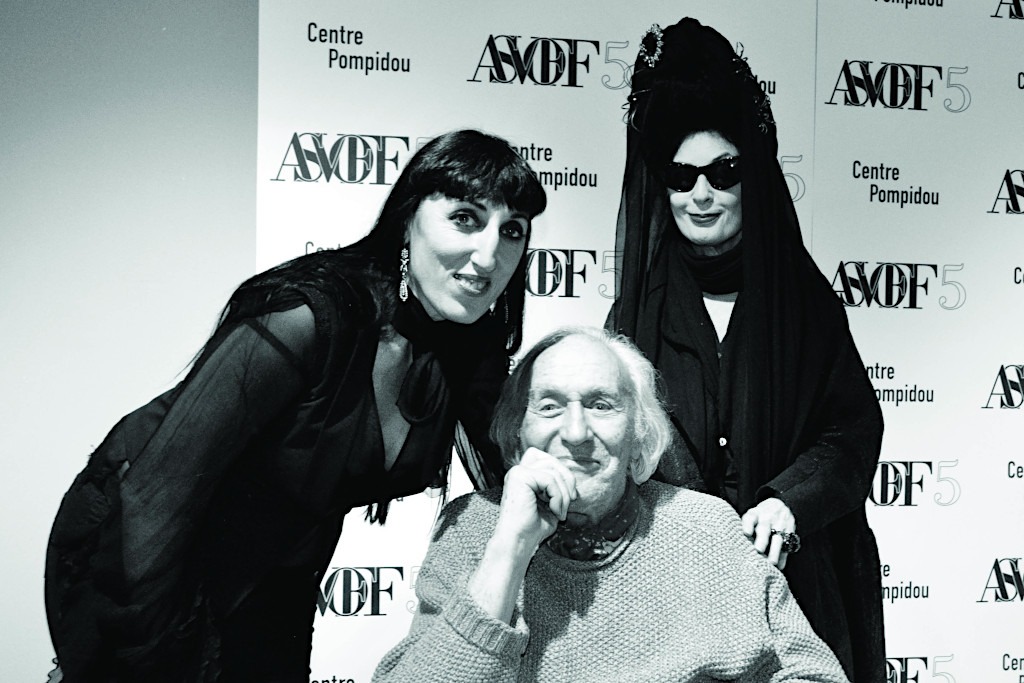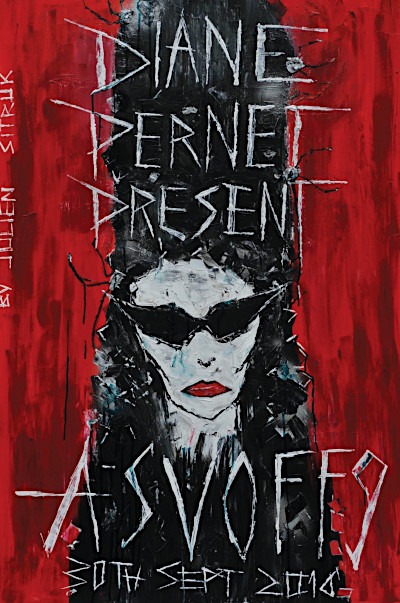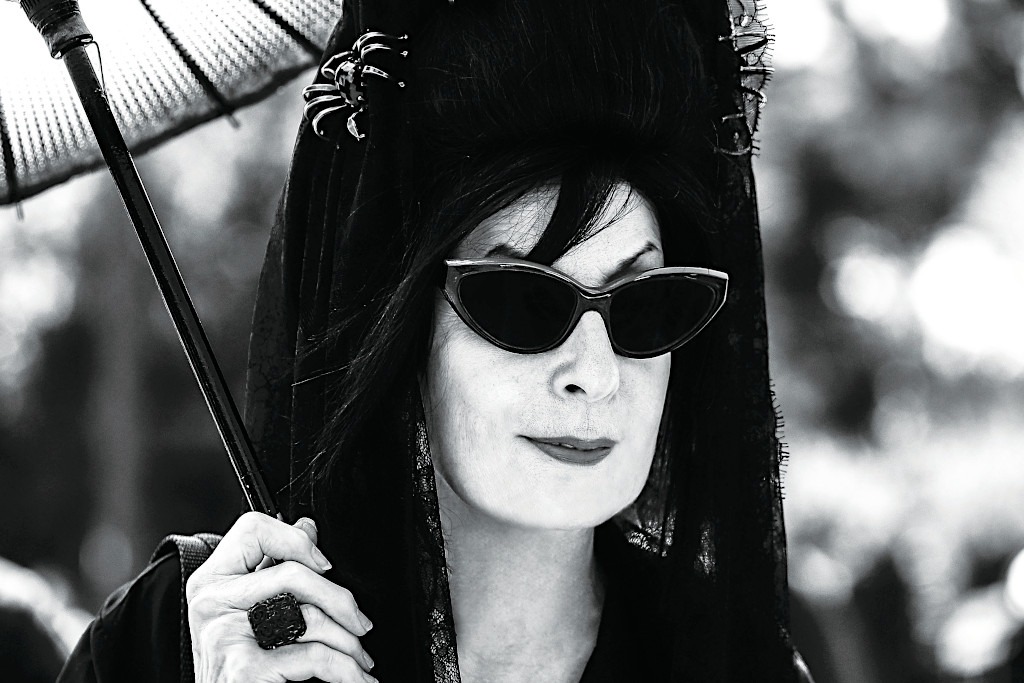I loathe using the word legendary, as it is the most overused word in the dictionary, now referencing Instagram influencers who have been around for six months. In a rare exception, I can say Diane Pernet (www.ashadedviewonfashion.com) is authentically legendary.
First off is her instant recognizability. She has been wearing the same uniform for over 30 years: black from head to toe, with a long black skirt covering her massively high platform shoes, and above the neck she dons a black lace mantilla, affixed with a jeweled spider pin, which travels from her hair down to almost her waist. The clincher is her cat-woman like sunglasses, which she never removes in public.
Pernet’s legendary status comes from her over five-decade career in fashion, working in almost every aspect of the business from fashion designer, to fashion editor, writer and blogger, to creating the world’s first fashion film festival. Pernet has witnessed the industry from many sides, always with a sharp eye and keen wit. Much of her sensibility and knowledge stems from her first love, film.
Pernet’s legendary status also comes from her ardent followers and cult status. Emulation is an everyday occurrence for Pernet, as her fans send her images they’ve made of her in the form of street art, posters, photo and art portraits, and T-shirts.
Although, Pernet may seem unapproachable in her black armor, she couldn’t have been more friendly and down to earth when we sat down for tea during this interview. Just to enforce her cult following, two fans in the space of 90-minutes came to our table, effusing their admiration of her and asking to take a photo.

William Klein, Rossy de
Palma, and Diane Pernet
ASVOFF 5 Centre Pompidou
Where were you born and where did you grow up?
I was born in Washington, D.C. but left at the age of three so I have no memory of it at all. I grew up on the Mainline outside of Philadelphia.
At what age did you your attraction to fashion start and what are your earliest memories that impacted you later on?
I was always into my clothes. As a young child I loved the color pink and was a bit obsessed with it. My room and my clothes were pink and very girly. I was probably more impressed by cinema stars than fashion designers. I poured over movie magazines and dreamed. I loved actresses like Sophia Loren and Anna Magnani. Films like The Rose Tattoo with Anna Magnani in a black slip stayed with me and I was always into the idea of innerwear being outerwear when I designed years later. I always had slip dresses in my collections. I loved Lucia Bose in Story of a Love Affair by Michelangelo Antonioni. The first designer that really made me want to do fashion was Charles Jame, a sculptor who only in the past few years has finally gotten his due. Also the Bauhaus movement in art had a big effect on my designing.
You lived in New York City for an extended period of time before you moved to Paris. Please tell me about your early years in New York.
Both of my parents were born in New York, so New York was always in my life. Living in Philadelphia one felt like you could be a big fish in a small pond, as the cliché goes, but that did not appeal to me so I moved to New York. It was after University where I studied film and communications at Temple. At first I did reportage photography then I went to Parsons and FIT for 9 months to study fashion. I quit and decided to open my own brand with zero experience, just a desire to create. The brand was my own name and I was in business for 13 years up until I decided that New York was unlivable with all the crime, homelessness, and the AIDS epidemic that wiped out 85-90% of my neighborhood. When I first moved to New York I was living at 873 Broadway in a loft above the ABC Carpets store. It was across the street from Andy Warhol’s factory. It was a great time for New York in the mid 70’s. Something about all the violence gave the city an energy, but it just got much worse by the end of the 80’s. After a few years doing photography, and after 9 months at two fashion schools, I launched my brand and worked out of a small apartment on West 11th street. It is funny, when I moved there in the mid 70’s there was an old time candy store on the corner of Bleeker next to me where teenagers used to hang out. They were great because if anyone bothered me they would tell them I was “neighborhood” and to leave me alone. Then rents went up, the candy store closed and then a bookstore moved in for years, it was Biography Bookstore, and now it is Marc Jacobs Bookmarc.
It was an exciting time in New York when you could get a loft with a theatre in it for $700 a month; imagine that? Artists could afford lofts and there was a great club scene. It was good for me because when a new club opened and they needed attention I could get the space for free for my shows and they took care of all the expenses. I met some great people like Anotonio Lopez. I finally got to meet Andy Warhol because I was friends with his PA Benjamin Liu, who later did the press for my last fashion shows in NYC. He was amazing and I might add so efficient. But from around 1987 till I moved in the end of 1990 New York was on a downward spiral, Tompkins square park wascardboard city. They cleaned up Washington Square Park and all the junkies moved to the park across from my window and life became unlivable. You could not walk on the street, crime was epic, people were dropping like flies from AIDS. The city changed and it was not a pretty picture, and especially not inspiring as a designer.

Image: Julien Sitruk
You were primarily a fashion designer when you lived in New York. What was that experience like?
I loved designing, I did it with my heart and soul. The fashion industry was never made for independents, not then and not now. Things like ordering fabric minimums were crazy and I ordered all of my textiles from France and Italy, which was crazy expensive, but they were beautiful. I did shows every season, and my big break came in 1985 when Seibu Department store picked up my brand and I got a license, which was wonderful because money came in three times a year and it could help support my own signature line. It also allowed me to travel, which I did after every collection to clear my head and come up with the inspiration for the new collection. That went on for 13 years. When I moved to Paris I had no strategy at all. I had a license with Dream Studio to design lingerie along with Isabelle Toledo and Estrada, which I thought would keep me going till I managed to figure out my way in Paris. Thing is, the husband of the Japanese woman that owned the brand
got in trouble with the Yakuza and pulled the plug on the brand.
What was the fashion scene like when you moved to Paris and who were the important designers at the time?
Fashion was more exciting in the early 90’s here with Thierry Mugler, Jean Paul Gaultier, Claude Montana, Lacroix, and Martine Sitbon. Shows were in the tents. It was strange for me because I was used to being the one on the catwalk not in the audience. My first job was with CBC as an assistant to the producer of Fashion Files where I reconnected with Tim Blanks who used to cover my shows in Paris. People used to sneak into the tents and wait for hours hiding from the guards to see Gaultier and other shows like Westwood. There was less interference from press people. Of course there were the Red Ties at the doors but still it was about energy and fashion—real creation.


